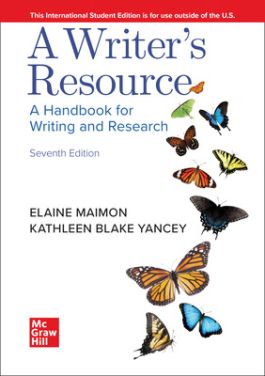A Writer's Resource (comb-version) Student Edition ISE
After purchasing your eBook, login to the McGraw Hill Bookshelf website and redeem the access code from your order confirmation email.
- Access your eBook online or offline
- Easily highlight and take notes
- Fully searchable content
- Syncs across platforms
NOTE: eBook purchase does not include Connect homework or adaptive SmartBook assignments
Tab 2: Writing and Designing Texts4. Reading and Writing: The Critical Connection5. Planning and Shaping6. Drafting Text and Visuals7. Revising and Editing8. Designing Academic Texts and Portfolios
Tab 3: Common Assignments9. Informative Reports10. Interpretive Analyses and Writing about Literature11. Arguments12. Other Kinds of Assignments13. Oral Presentations14. Multimodal Writing
Tab 4: Writing Beyond College15. Service Learning and Community-Service Writing16. Writing to Raise Awareness and Share Concern17. Writing to Get and keep a Job
Tab 5: Researching18. Understanding Research19. Finding and Managing Print and Online Sources10. Finding and Creating Effective Visuals, Audio Clips, and Videos21. Evaluating Sources22. Doing Research in the Archive, Field, and Lab23. Plagiarism, Copyright, and Intellectual Property24. Working with Sources and Avoiding Plagiarism25. Writing the Paper
Tab 6: MLA Documentation Style26. MLA Style: In-Text Citations27. MLA Style: List of Works Cited28. MLA Style: Explanatory Notes and Acknowledgments29. MLA Style: Format30. Sample Research Project in MLA Style
Tab 7: APA Documentation Style31. APA Style: In-Text Citations32. APA Style: References33. APA Style: Format34. Sample Research Project in APA Style
Tab 8: Chicago and CSE Documentation Style35. Chicago Documentation Style Elements36. Sample from a Student Research Project in Chicago Style37. CSE Documentation Style
Tab 9: Editing for Clarity38. Wordy Sentences39. Missing Words40. Mixed Constructions41. Confusing Shifts42. Faulty Parallelism43. Misplaced/Dangling Modifiers44. Coordination and Subordination45. Sentence Variety46. Active Verbs47. Appropriate Language48. Exact Language49. The Dictionary and the Thesaurus50. Glossary of Usage
Tab 10: Editing for Grammar Conventions51. Sentence Fragments52. Comma Splices and Run-on Sentences53. Subject-Verb Agreement54. Problems with Verbs55. Problems with Pronouns56. Problems with Adjectives and Adverbs
Tab 11: Editing for Correctness: Punctuation, Mechanics, and Spelling57. Commas58. Semicolons59. Colons60. Apostrophes61. Quotation Marks62. Other Punctuation Marks63. Capitalization64. Abbreviations and Symbols65. Numbers66. Italics (Underlining)67. Hyphens68. Spelling
Tab 12: Basic Grammar Review with Tips for Multilingual Writers69. Parts of Speech70. Parts of Sentences71. Phrases and Dependent Clauses72. Types of Sentences
Tab 13: Further Resources for LearningSelected Terms from across the CurriculumDiscipline-Specific ResourcesTimeline of World EventsWorld MapIndexIndex for Multilingual WritersQuick Guide to Key ResourcesAbbreviations and Symbols for Editing and Proofreading
A Writer’s Resource helps writers identify the fundamental elements of any writing situation, and teaches innovative, transferable strategies that build confidence for composing across various genres, media, and the academic curriculum. With numerous examples from a rich cross-section of disciplines, A Writer’s Resource demonstrates that nearly every field of study and potential career path depends on written communication.
A Writer’s Resource’s accompanying Connect digital platform (with 4-year access) offers instructors more options for instruction, assessment, and reporting. Writing Assignment (available in Connect) has been enhanced with easy-to-use Peer Review functionality, making it convenient to assign and assess peer review performance. A Writer’s Resource 7e aligns fully with the 9th edition of the MLA Handbook and the 7th edition of the APA Manual.

